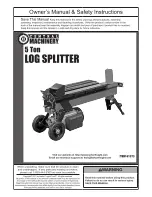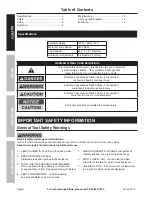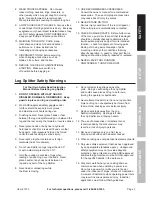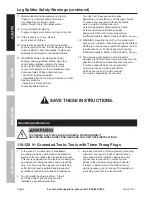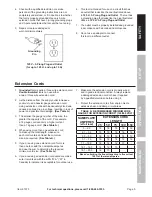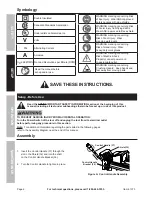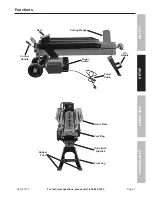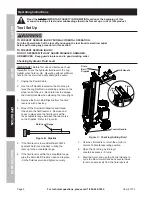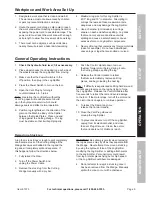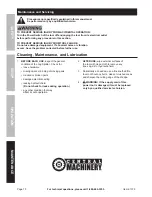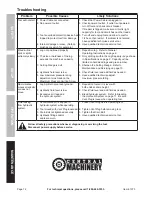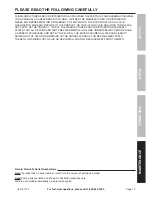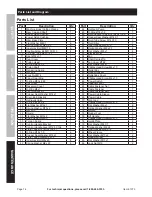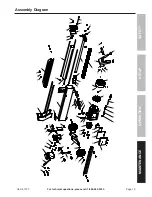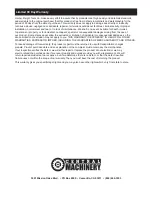
Page 11
For technical questions, please call 1-800-444-3353.
Item 61373
SAFET
y
Op
ERA
TION
M
AINTENAN
c
E
SETU
p
Hydraulic Fluid Maintenance / Bleeding
Change the hydraulic fluid in the Log
Splitter after every 100 hours of use.
Replacing Hydraulic Fluid
1. Remove the Rubber Feet from
the ends of the Front Leg.
2. Place the Front Leg of the tool in a five quart
or greater capacity container. Raise the
wheeled end of the Log Splitter using blocks
and wheel chocks (not included), tilting the unit
to an angle of approximately 30 degrees.
Vent plug
Front Leg
Drain Bolt /
Dipstick
Figure D: Draining the Fluid Reservoir
3. Remove the Drain Bolt / Dipstick with a hex
key, disconnect the Vent Plug and drain the
fluid reservoir. Dispose of the old hydraulic
fluid in accordance with local regulations.
4. After the fluid has drained from the fluid
reservoir, use the Lift Handle located on the
Front Leg to raise the Log Splitter to a standing
position on the wheel end of the unit. Be
careful not to damage the Control Handle when
standing the tool upright. Refer to Figure C:
Checking / Adding Fluid on page 8.
5. Refill the fluid reservoir with 3.4 quarts (3.2 liters)
of fresh AW32 hydraulic fluid (not included).
Note:
If AW32 hydraulic fluid is not available,
Dextron II automatic transmission fluid may be
used as a substitute. DO NOT mix Dextron II
with AW32 hydraulic fluid—drain reservoir
completely if substituting Dextron II.
6. Wipe off the Drain Bolt / Dipstick and thread it
into the fluid reservoir. Remove and check to
make sure the fluid level is within the acceptable
range between the two marks on the Dipstick.
Refer to Figure B: Dipstick on page 8.
7. Replace the Vent Plug and Drain
Bolt / Dipstick. Tighten securely.
8. Replace the Rubber Feet on the
ends of the Front Leg.
9. Use the Lift Handle to return the unit to its
normal, horizontal operating position.
10. Open the Vent Plug by turning it
counterclockwise 4 – 5 turns.
11. Plug in the tool, start the motor and use the Control
Handle to cycle the Ram forward and back several
times to remove excess air from the fluid reservoir.
Bleeding the Hydraulic System
Trapped air may accumulate in the fluid reservoir
causing the Ram to move erratically or not at all,
making it necessary to bleed the hydraulic system
of excess air. To bleed the hydraulic system:
1. Unplug the Power Cable.
2. Use the Lift Handle located on the Front Leg
to raise the Log Splitter to a standing position
on the wheel end of the unit. Be careful
not to damage the Control Handle when
standing the tool upright. Refer to Figure C:
Checking / Adding Fluid on page 8.
3. Remove the Drain Bolt / Dipstick
with a hex key.
4. Wipe off the Drain Bolt / Dipstick and thread
it back into the fluid reservoir. Remove and
check the fluid level; add fluid as needed
to bring within the acceptable range. Refer
to Figure B: Dipstick on page 8.
5. Replace the Drain Bolt / Dipstick and
tighten securely.
6. Use the Lift Handle to return the unit to its
normal, horizontal operating position.
7. Open the Vent Plug by turning it
counterclockwise 4 – 5 turns.
8. Plug in the tool, start the motor and use the Control
Handle to cycle the Ram forward and back several
times to remove excess air from the fluid reservoir.
Summary of Contents for 61373
Page 1: ......

